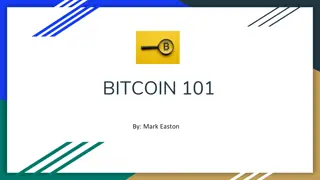Exploring the Role of Blockchain as a Trusted Third Party in Decentralized Systems
Blockchain technology serves as a decentralized and cryptographic Trusted Third Party (TTP) by enhancing trust, immutability, and censorship resistance in transactions. By distributing trust and utilizing cryptographic protocols, blockchain mitigates the need for a centralized authority, offering a robust framework for secure and immutable data handling. The current functionality of blockchains as TTPs involves validating the state of ledgers and smart contracts, showcasing the power and challenges of decentralized consensus.
Uploaded on Sep 30, 2024 | 0 Views
Download Presentation

Please find below an Image/Link to download the presentation.
The content on the website is provided AS IS for your information and personal use only. It may not be sold, licensed, or shared on other websites without obtaining consent from the author.If you encounter any issues during the download, it is possible that the publisher has removed the file from their server.
You are allowed to download the files provided on this website for personal or commercial use, subject to the condition that they are used lawfully. All files are the property of their respective owners.
The content on the website is provided AS IS for your information and personal use only. It may not be sold, licensed, or shared on other websites without obtaining consent from the author.
E N D
Presentation Transcript
BLOCKCHAIN AS A TRUSTED THIRD PARTY Craig Gentry Berkeley Course on Decentralized Systems
What is a blockchain good for? Common answer: blockchain buzzword bonanza! Decentralized Scalable Secure Immutable Censorship-resistant Trustless Blockchain s special sauce Blockchain Trilemma Essential So what? Why should I want these things?
So what? Why should I want these things? Decentralization: No single party has undue influence. But centralized solutions (like Visa) work fine. Immutability: Transactions are irreversible. But what if I make a mistake and want to reverse a transaction? Censorship-resistance: Nobody can silence you or anyone else. But what if we want to remove content that is criminal or harmful? Trustlessness: Blockchain uses cryptography to eliminate the need for trust Then why so many scams? And how do we check integrity of data entered into the blockchain?
Suggestion: Maybe using buzzwords some ambiguous, and some that sound questionable or even scary is not the best way to make your case? Fair point. Let s give a more formal and fundamental answer.
What is blockchain good for? Blockchain is our most efficient & robust construction of the ideal trusted third party (TTP) from cryptography The TTP is decentralized Decentralization makes trust more robust to corruption by distributing it Harder to corrupt a big group The TTP is cryptographic Trusted to run cryptographic protocols correctly Not trusted to walk your dog, or provide good legal advice A decentralized cryptographic TTP is very useful!
Current blockchains as cryptographic TTPs TTP functionality of current blockchains: Validate state (e.g. of a ledger or SCs) as it comes in (append only) This functionality immutability, censorship-res., consensus Decentralized consensus is surprisingly difficult and powerful!
Current blockchains as cryptographic TTPs TTP functionality of current blockchains: Validate state (e.g. of a ledger or SCs) as it comes in (append only) This functionality immutability, censorship-res., consensus Decentralized consensus is surprisingly difficult and powerful! Get usual buzzword properties at transaction level Emergent properties at network level Agreed-upon state and rules allow ecosystems to thrive Lifting local consensus (e.g., about assets) to global consensus has value by making those assets more visible/usable Example by economist Hernando de Soto Polar on capitalism: Capital formation thrives when there is broad consensus on property laws and assets. What owners can do with their assets benefits from the collective imagination of a larger network of people.
Future Blockchains as Cryptographic TTPs Empower the TTP to do other cryptographic functionalities! For many functionalities, the TTP needs to keep a secret This Photo by Unknown Author is licensed under CC BY-NC-ND ?1 ?(?1,?2,?3) ?2 ?3
The Power of a Secret Basic security setting: Client deposits secret at blockchain To be revealed only when the time is right More generally used only in the prescribed manner Blockchain can keep a secret Anyone can keep a secret at the blockchain to be opened conditioned on some event
Information Bazaar Example: Information marketplace of user-controlled data User deposits secret (e.g., genomic) data, and specifies policy of how the data can be shared (e.g., to medical researchers) Researchers collect encrypted data with permissive policies, use homomorphic encryption to process the encrypted data, and use a SNARK to prove correct evaluation After verifying SNARK, blockchain decrypts the final result User surgically controls and monetizes its data in a way that is basically impossible without cryptography Huge! Opens up economies that might not exist otherwise
Can a Blockchain Keep a Secret? Fabrice Benhamouda, Craig Gentry, Sergey Gorbunov, Shai Halevi, Hugo Krawczyk, Chengyu Lin, Tal Rabin, Leonid Reyzin eprint.iacr.org/2020/464
The Challenge Secrecy: the secret must remain a secret Unknown to the adversary, but still recoverable As long as we have honest majority of stake Even when the adversary is mobile Efficiency: want a scalable solution Communication/work does not increase as time goes by, or as more nodes are joining the network Plausible practicality: No obfuscation/witness-encryption Want solutions based on proactive secret-sharing
Proactive Secret-Sharing [OY91,CH93,] Periodic runs of a share-refresh protocol reshare reshare reshare reshare ?1 ?2 ?3 ?4 The secret remains a secret as long as each committee separately has honest majority Even if different parties are corrupted in different times
Why is it Hard on a Public Blockchain? For scalability, communication only by a small committee But then a mobile adversary can corrupt them all Previous work assumed assumed that committees have honest majority We provide a mechanism to ensure it Solution: keep committee members anonymous So adversary cannot target them Player replaceability: Player replaceability: a committee member sends a single message, revealing its identity only after completing its job How to (re)share a secret among an unknown committee? only after completing its job
Some Directions that do not Work The secret-sharing committee self-selects (via sortition) Previous committee doesn t know who to pass the secret to ? reshare Each committee member selects its successor Corrupted members will always corrupt their successors Honest members will choose a corrupted successor w/ prob. ? Committee will have a dishonest majority soon enough reshare reshare reshare reshare ?3 ?4 ?1 ?2
Wouldnt it be great if we had A target-anonymous channel functionality ?visible input ports, ? hidden output ports Random assignment of the output ports to an ?-subset of the ? users ?1 ?2 ?1 ?3 ?2 ?4 ?3 ?5 ?6 ?? ??
Wouldnt it be great if we had A target-anonymous channel functionality ?visible input ports, ? hidden output ports Random assignment of the output ports to an ?-subset of the ? users Anyone can send on the ? th input port, not knowing who will receive the message Current committee can re-share the secret using the ? input ports Shares sent to a new random committee ?1 ?2 ?1 ?3 ?2 ?4 ?3 ?5 ?6 ?? ??
Wouldnt it be great if we had A target-anonymous channel functionality ?visible input ports, ? hidden output ports Random assignment of the output ports to an ?-subset of the ? users Anyone can send on the ? th input port, not knowing who will receive the message Current committee can re-share the secret using the ? input ports Shares sent to a new random committee ?1 ?2 ?1 ?3 ?2 ?4 ?3 ?5 ?6 Doesn t solve everything, but helps a lot ?? ??
Tools Cryptographic sortition (using verifiable random functions) Allows a committee to self-select Members can prove that they were selected PKI and a broadcast channel Both provided by the blockchain Anonymous public-key encryption Given ???,???,??, , hard to tell under which ??? it was encrypted
Approximating Target-Anonymous Channels An ?-member nominating committee self-selects Each nominator ??: Chooses a nominee ?? among the ? parties At random if the nominator is honest Draws a new key pair ??? Encrypts ??? Using anonymous PKE anonymous PKE, ??? does not betray ?? Broadcasts the pair (??? Everyone can encrypt/broadcast messages under ??? ?? can recover ??? ,??? ?????? $ under the public key of ?? to get ??? ????????? ,???) and then decrypt
Nominators Need Not Prove Anything Corrupted nominators can (e.g.) nominate their friends Proofs wouldn t have worked anyways: Even if forced to behave honestly, a corrupted nominator could turn around and corrupt its randomly-chosen nominee Also: such proofs have long statements Statements that include everyone s public keys So producing the proof is not scalable
Resilience of Our Target-Anonymous Channels If adversary controls ?-fraction of the stake/parties Then it controls ?-fraction of the nominators Corrupted nominators choose corrupted nominees Honest nominators choose corrupted nominees w.p. ? Chosen committee will have 2?-fraction corruptions To ensure honest majority of the chosen committee, we need to assume ? < 1 4
The Overall Solution ?1 ?2 ?3 ?4 Nominating committees reshare reshare reshare reshare Secret-sharing committees ?1 ?2 ?3 ?4 Re-sharing requires NIZK Only for short statements with short witnesses Depends only on the committee size Hence solution is scalable
The End Result A scalable proactive secret-sharing protocol With player replaceability Assuming that the adversary controls < of the stake Room for improvement here Can be implemented under DDH, DCR, LWE, Requires anonymous encryption under selective opening attacks Can conceivably be made practical Involves only proving short statements with short witnesses , independent of total stake or the blockchain history
Problems Left Open Do more with the secret Don t just keep it, compute on it (in the pipeline) Improve resilience of target-anonymous channels From ? < 1 4, hopefully to While keeping it scalable ? < 1 2
Better committee selection and f resilience Random-Index PIR and Applications , Craig Gentry, Shai Halevi, Bernardo Magri, Jesper Buus Nielsen, and Sophia Yakoubov. eprint.iacr.org/2020/1248 Recall double-dipping attack: dishonest nominators pick dishonest nominees Countermeasure: Use MPC on blockchain to emulate honest nominators Don t need general MPC: just a simple primitive (RPIR) to sample a random key together with its index
Practical NIZKs for resharing of secrets using lattice-based encryption Practical Non-interactive Publicly Verifiable Secret Sharing with Thousands of Parties , Craig Gentry, Shai Halevi, Vadim Lyubashevsky. eprint.iacr.org/2021/1397 Efficient encryption for the shares Regev encryption with packing many messages per ciphertext Efficient proofs of correct sharing Bulletproof for proving linear/quadratic relations Various proofs of smallness
Exploration of the You-Only-Speak-Once (YOSO) Model (relating to player replaceability) YOSO: You Only Speak Once: Secure MPC with Stateless Ephemeral Roles , Craig Gentry, Shai Halevi, Hugo Krawczyk, Bernardo Magri, Jesper Buus Nielsen, Tal Rabin, and Sophia Yakoubov. eprint.iacr.org/2021/210 YOSO is useful in other contexts (not just blockchain) To defeat DDoS attacks In computing with stateless components The paper defines, explores and constructs YOSO MPC























